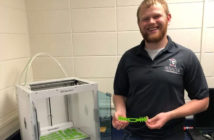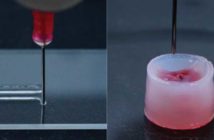
At the University of California, Los Angeles (UCLA), researchers have developed a technique that uses a specially adapted 3D printer to build therapeutic biomaterials from multiple materials. They are hoping the on-demand 3D printing of complex skin-like tissues could be used in transplants and other surgeries in the near future.
Tissues are wonderfully complex structures, so to engineer artificial versions of them that function properly, we have to recreate their complexity. Our new approach offers a way to build complex biocompatible structures made from different materials,”
-Ali Khademhosseini, UCLA (who led the study)-
A study published on the last Monday says that Khademhosseini’s 3D printer has two key components:
- The first is a custom-built microfluidic chip, a small, flat platform similar in size to a computer chip that handles the flow of liquids. It has multiple inlets that each “prints” a different material.
- The second component is a digital micromirror, an array of more than a million tiny mirrors that each moves independently.

The technique
uses a light-based process called automated stereolithographic bioprinting. The micromirrors direct light onto the printing surface, and the illuminated areas indicate the outline of the 3D object that’s being printed. The light also triggers molecular bonds to form in a variety of hydrogel bioinks, which causes the gels to firm into solid material. As the 3D object is printed, the mirror array changes the light pattern to indicate the shape of each new layer.
The process
Is the first to use multiple materials for automated stereolithographic bioprinting, as conventional stereolithographic bioprinting only uses one type of material. Khademhosseini says that
The researchers used four types of bioinks, but says in their study that the process could use as many inks as needed.
Researchers first used the Additive Manufacturing process to make simple shapes, such as pyramids. Then, they moved on to complex 3D structures that imitated parts of muscle tissue and muscle-skeleton connective tissues. They then 3D printed shapes mimicking tumors with networks of blood vessels. Researchers tested the 3D printed structures by implanting them in rats. The rats’ bodies incorporated the artificial materials, the structures were not rejected. These 3D printed tumors allow researchers to test biological models in studies on various cancers.
The co-senior author of the study is Yu Shrike Zhang of Brigham and Women’s Hospital and Harvard Medical School. The other authors are from University of Santiago de Compostela, Spain; Sharif University of Technology, Iran; and UC San Diego.
- Sources & More information
-
Related article categories:
Medical and dentalArticle and featured image:
3Ders.org Tim Patterson May 15th, 2018 Researchers develop 3D printer that can make complex body tissues http://www.3ders.org/articles/20180515-researchers-develop-3d-printer-that-can-make-complex-body-tissues.html visited on May 16th, 2018; Posted in 3D Printing Application.
University of California logo https://www.mercurynews.com/2012/12/06/university-of-california-introduces-a-modern-logo/ visited on May 16th, 2018;
additivenews.com




